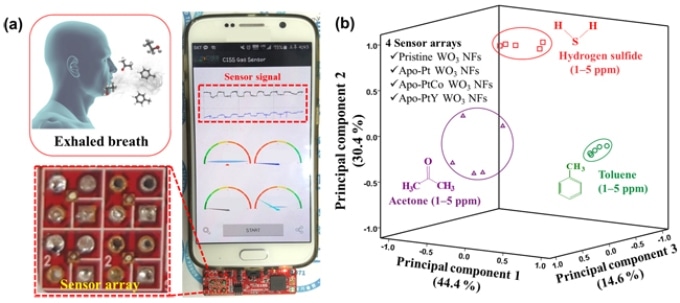Jul 20 2017
Breath pattern recognition is considered to be a futuristic diagnostic platform. The disease as well as the physical condition can be diagnosed by simple characterizing target gas concentrations of human exhaled breath.
 Sensing Device Credit: KAIST
Sensing Device Credit: KAIST
A research group headed by Prof. Il-Doo Kim in the Department of Materials Science has produced diagnostic sensors using protein-encapsulated nanocatalysts, which could help in diagnosing specific diseases by examining human exhaled breath. This new technology enables early monitoring of different diseases via pattern recognition of biomarker gases associated with diseases in human exhalation.
The protein-templated catalyst synthesis route is extremely simple and versatile for developing just one component of catalytic nanoparticles and also diverse heterogeneous intermetallic catalysts that are less than 3 nm. The Researchers have developed chemiresistive sensors that are a lot more sensitive and selective and that which are capable of potentially diagnosing particular diseases by analyzing exhaled breath gases.
The outcomes of this study, which were contributed by Dr. Sang-Joon Kim and Dr. Seon-Jin Choi as First Authors, were chosen as the cover-featured article in the July edition of 'Accounts of Chemical Research,' the American Chemical Society’s international journal.
In human breath, diverse components are detected including hydrogen, water vapor, acetone, toluene, ammonia, carbon monoxide and hydrogen sulfide, which are increasingly exhaled from patients. A few of these components are associated with diseases such as halitosis, type 1 diabetes mellitus, lung cancer and asthma.
Breath analysis for diagnosing disease commenced by capturing exhaled breaths in a Tedlar bag and the captured breath gases were then injected into a miniaturized sensor system, resembling an alcohol detector. Exhaled breath can be rapidly analyzed with the help of a simple analyzing process. The breath analysis is capable of detecting trace variations in exhaled breath components, thus contributing to early diagnosis of diseases.
However, technological improvements are essential for accurately analyzing gases in the breath, which occur at extremely low levels, from 1 ppb to 1 ppm. To be more specific, it has been a major challenge for chemiresistive type chemical sensors to detect specific biomarkers in a selective manner amongst thousands of interfering gases including humid vapor.
Traditionally, noble metallic catalysts such as palladium and platinum have been functionalized onto metal oxide sensing layers. However, the gas sensitivity was not adequate enough to identify ppb-levels of biomarker species in exhaled breath.
The Researchers overcame the existing limitations by using nanoscale protein (apoferritin) in animals as sacrificial templates. The protein templates comprise of hollow nanocages at the core site and different alloy catalytic nanoparticles capable of being encapsulated within the protein nanocages.
The protein nanocages are beneficial because of the possibility to assemble a nearly unlimited number of material compositions in the periodic table for synthesizing heterogeneous catalytic nanoparticles. Additionally, intermetallic nanocatalysts with a controlled atomic ratio of two varied elements can be obtained by employing the protein nanocages, which is a gorund-breaking strategy for detecting new types of catalysts. For instance, greatly efficient platinum-based catalysts can be synthesized, such as platinum-yttrium (PtY), platinum-ruthenium (PtRu), platinum-nickel (PtNi) and platinum-palladium (PtPd).
The team succeeded in producing exceptional sensing layers made up of metal oxide nanofibers functionalized by the heterogeneous catalysts with bigger and highly-porous surface areas, which are specifically optimized for selective detection of particular biomarkers. The biomarker sensing performance was improved approximately 3~4-fold as compared to the standard single component of palladium and platinum catalysts-loaded nanofiber sensors. The team used the heterogeneous nanocatalysts to particularly observe 100-fold resistance transitions toward acetone (1 ppm) and hydrogen sulfide (1 ppm) in exhaled breath sensors, which is considered to be best performance that has ever been reported in literature.
The Researchers created a disease diagnosis platform capable of recognizing independent breathing patterns by using a multiple sensor array system comprising of diverse sensing layers and heterogeneous catalysts, allowing people to effortlessly identify health abnormalities. A 16 sensor array system will help in continuously monitoring the physical conditions by analyzing concentration variations of biomarkers in exhaled breath gases.
New types of heterogeneous nanocatalysts were synthesized using protein templates with sizes around 2 nm and functionalized on various metal oxide nanofiber sensing layers. The established sensing libraries can detect biomarker species with high sensitivity and selectivity. The new and innovative breath gas analysis platform will be very helpful for reducing medical expenditures and continuous monitoring of physical conditions.
Prof. Il-Doo Kim, the Department of Materials Science
In March and June this year, patents related to this technology were licensed to two companies.